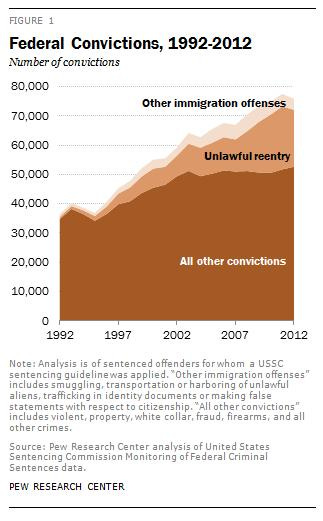Imprisoning Immigrants
If you read the tables in my last post carefully, you might have noticed that 10.6% of federal inmates – over 20,000 people – are serving time for immigration offenses. This seems very weird. Stereotypes say that illegal immigrants are punished with deportation, not prison. What’s going on?
The answer: This stereotype is fast becoming obsolete. Federal imprisonment for illegal immigration has exploded during the last two decades. The numbers, via the Pew Hispanic Trends Project:

The basic facts: First-time illegal immigrants are unlikely to go to prison. But if you’re caught, deported, and caught again, you are now fairly likely to be charged with “illegal reentry.” Pew’s Light, Lopez, and Gonzalez-Barrera explain:
Between 1992 and 2012, the number of offenders sentenced in federal
courts more than doubled, rising from 36,564 cases to 75,867. At the same time, the number of unlawful reentry convictions increased 28-fold, from 690 cases in 1992 to 19,463 in 2012. The increase in unlawful reentry convictions alone accounts for nearly
half (48%) of the growth in the total number of offenders sentenced in
federal courts over the period. By contrast, the second fastest growing
type of conviction–for drug offenses–accounted for 22% of the growth.Immigrants charged with unlawful reentry–a federal crime–have entered
or attempted to enter the U.S. illegally more than once. They may also
have attempted to reenter the U.S. after having been officially
deported.
Changes in annual sentencing patterns take a long time to fully show up in overall incarceration numbers, so the 10.6% number is only the tip of a rising iceberg.
The rising number of convictions for unlawful reentry has altered the
offense composition of federal offenders. In 2012, immigration
offenses–of which unlawful reentry is the largest category–represented
30% of offenders, up from 5% in 1992.
Unlawful reentry cases alone accounted for 26% of sentenced federal
offenders–second only to drug offenses in 2012. This is up 13-fold since
1992, when offenders sentenced for unlawful reentry made up just 2% of
sentenced offenders.
In light of these facts, I’m backing away from my earlier judgment that the difference between deportation and “voluntary returns” is almost entirely cosmetic. I used to think that voluntary returns were about 95% as bad as deportations; now I’d say 85%. Mea culpa.
Read the whole Pew piece here.
The post appeared first on Econlib.

